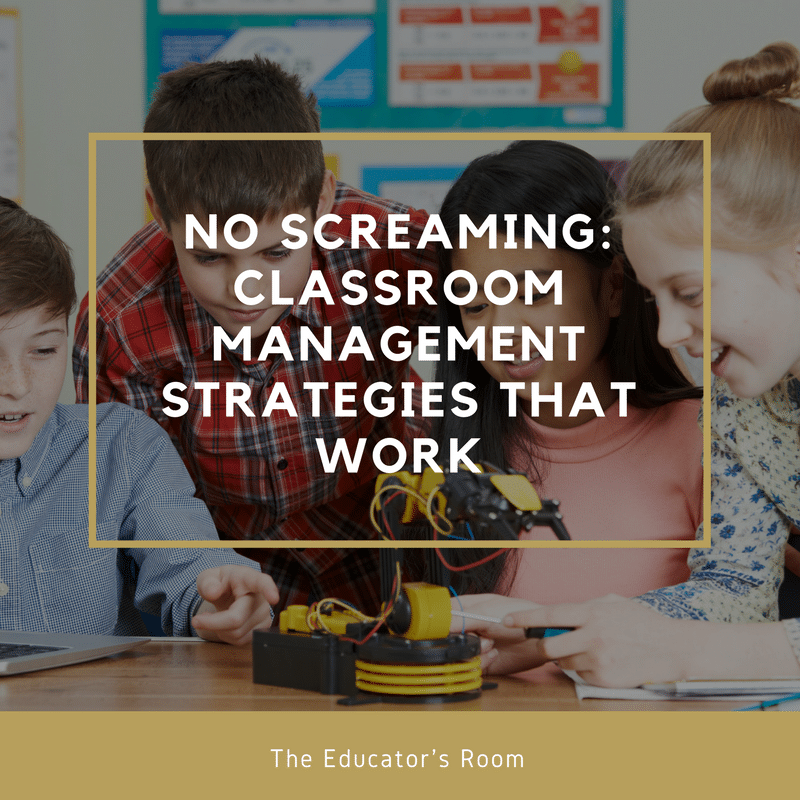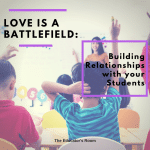Screaming can be an effective classroom management strategy if your goal is to get scared children to obey your words. It also could cause students to revolt. Why do we do it? We scream because we’re upset. We scream because it’s effective… well the first few times.
The other day I led a group of young children in a class setting. A child approached me saying how sad he felt about his dad screaming at him all the time. The child explained that he sometimes misbehaved and his dad would yell at him. After his dad yelled, he sat on the couch crying. I reflected and realized that this scene sounds like something that might happen in my own house. Every time I raise my voice, my children stop their misbehavior and turn on the waterworks. I get my children to stop their misbehavior but lose a part of my relationship with them. This could be applied to the classroom too.
One year, I taught next to a screaming teacher. I’m not saying that I never lost my temper or that I never raised my voice. I’ll admit, I’m anything but perfect. When I saw this constant behavior in a fellow teacher, I got a better view of the effects of screaming at children. Some things I noticed were that children were relieved to enter into a different classroom, the screaming did not get less intense during the school year and that even I was a bit scared to enter the classroom.
[bctt tweet=”I was a bit scared to enter the classroom” username=””]
I know we teachers have a tough job and sometimes we have less support from the administration than we’d like to have in the classroom. I also know that most of us got into teaching because we wanted to make a difference in other people’s lives- possibly to even invest in a future generation. Whatever the reason, I know that I never dreamed of getting into teaching just to do a job. I never dreamed of tearing down a person by yelling and that lingering with them for years or more.
According to a study, children can have negative effects from harsh verbal discipline well into adulthood. A lot of us wouldn’t dream of physically harming our students, but we emotionally harm them with our yelling. Our words and tone do matter as parents and as teachers. We spend a lot of time with the children in our classes and our words have the power to build up the students or tear them down. Even with a severely misbehaved student who takes joy in watching his or her teacher get annoyed, there are more effective options.
Classroom management strategies to prevent us from screaming:
Remind yourself that this is a human being and this person could have been you.
It may sound corny, but perspective can make all the difference. If you were that child, how would you have wanted someone to guide you?
Have students commit to our classroom rules.
When students actively agree to rules, this doesn’t mean they won’t break them. This means that they acknowledge that the rules are good for the class. When they do something wrong, we have a broken agreement and an easy respectful way to discuss misbehavior.
Write love notes to your students, especially the challenging ones.
This practice nearly annihilated any urge I had to yell. Something about spending the time to remember their good qualities and writing it down made each individual not just the sum of their behavior. It made them a cherished person in my classroom. Many students saved the cards and read them long after I wrote the notes. Even, the hardest to reach student would be softened with gentle encouragement.
Put distance between the crime and your words.
If the behavior was so bad you just want to burst, have the student step outside or go to a location in the classroom to reflect on the behavior. This reflection time gave me time to cool off. If the behavior is an offense that needs immediate attention, stop the behavior using minimal words. Then, work it out with the student when you are more level headed.
Use brain based classroom management strategies.
I found that brain based strategies prevent major misbehavior. I learned that my goal was to get students to feel calm, safe and like this was their home court on their team. For the most part, students don’t want to destroy a good thing.
Ask good questions.
Good questions get the student thinking about their behavior. When I asked questions that got to the heart of the behavior, students were no longer giving me their rebellious nature. Instead, I got heart felt stories and motives that weren’t so bad though their behavior was bad. I had something better to work with when we got to the root of the problem. I can direct a child struggling with jealousy. Directing a child struggling with the feelings of injustice is also possible. I cannot direct a child who is seethed with anger and especially if that anger is toward me.
Set up a behavior space and walk towards it.
When the class is off, step out of the fun teacher box and step into the police/lawyer/judge space. This isn’t a screaming space, but a time to use my deeper voice, stern eyes and squared shoulders in the rule section of the room. Something about walking to the space helped me to keep perspective. I didn’t wait for students to magically behave, but I spoke firmly and slow reminding them of our agreement. I also reminded them of who they were, on their good days. This worked only with a personal relationship with each of my students.
Cultivate a personal relationship with each student.
This means eating lunch with students, spending after school time through clubs or school activities, and making sure to have heart felt conversations. The better my relationship was with my students, the easier it was to correct their behavior. Good relationships made it easier not to want to yell. Instead, we had our own special way of talking to each other that was more effective at correcting behavior. This form of correction was long lasting too.
Most of the strategies that work best require a lot of ground work before the situation arises. When it comes time to correcting behavior, screaming isn’t as much of the go-to anymore with these strategies. If you do slip-up, it probably will be more effective because it will be out of character. They’ll know you mean business or that you’re having a bad day. The only problem is that you pulled from the relational bank you created with your students. It’s not worth losing in the investment you already made.

Resources:
http://commonhealth.legacy.wbur.org/2013/09/yelling-at-kids-comparable-physical-punishment-study
http://onlinelibrary.wiley.com/doi/10.1111/cdev.12143/abstract







Yelling is never the answer. Like you said, you need to cultivate a relationship with your students. I couldn’t agree more with that. If you’re looking for alternative techniques about handling students, here’s an article about it: https://westendinschools.org.uk/blog/creative-classroom-management-part-3
Cheers!
– Paul